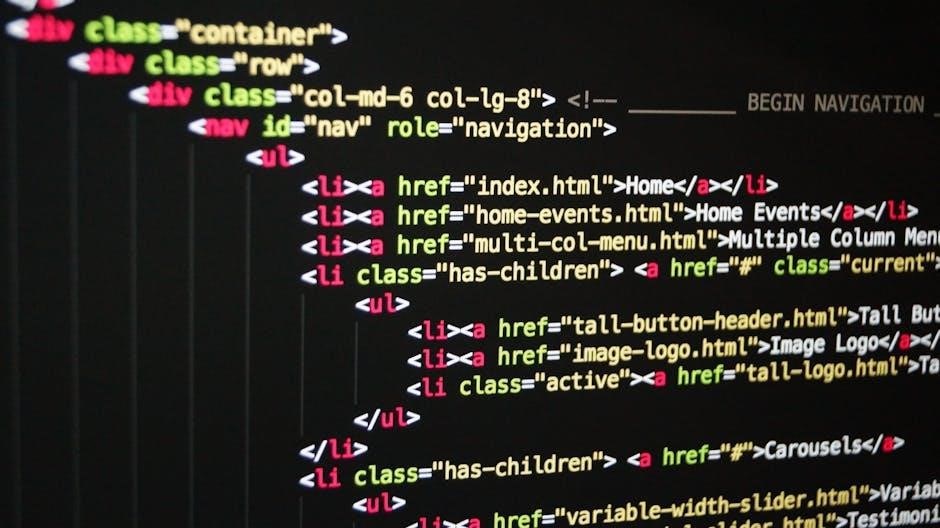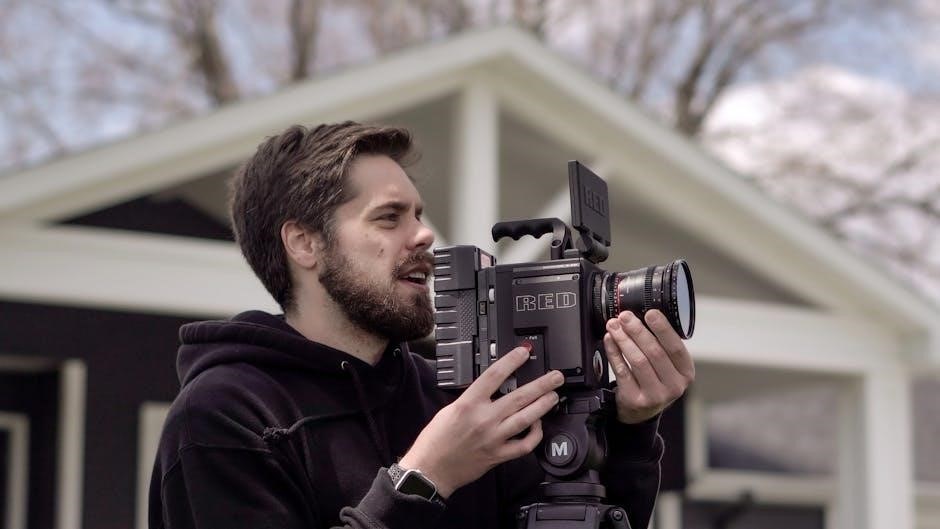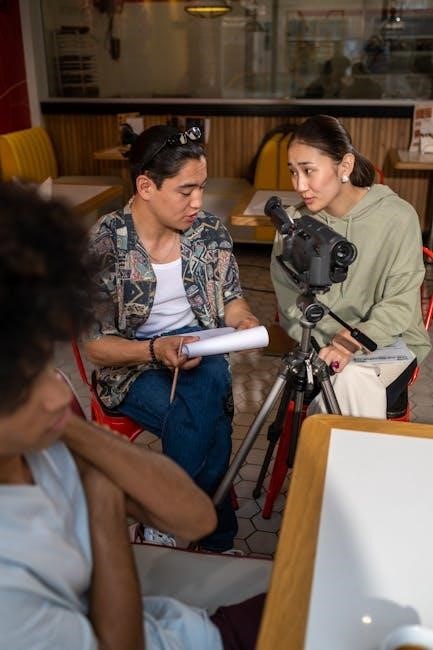Camera scripts are essential tools for filmmakers, providing a detailed plan for camera operators, with the
final version
including instructions for camera placement and movement, ensuring a smooth production process always.
Definition and Purpose
A camera script is a document that outlines the shots and sequences for a film or video production, with the final version including instructions for camera operators.
The purpose of a camera script is to provide a clear plan for the camera operators, ensuring that each shot is captured as intended.
This document is typically created by the director or cinematographer and is used to communicate their vision to the camera team.
The camera script includes details such as camera angles, lighting, and movement, as well as any specific instructions for the camera operators.
By having a clear plan in place, the camera script helps to ensure that the production runs smoothly and that the final product meets the director’s vision.
The camera script is an essential tool for filmmakers, allowing them to bring their ideas to life on screen.
It provides a roadmap for the camera team, ensuring that each shot is captured correctly and that the final product is of high quality.
Overall, the camera script plays a critical role in the production process, helping to bring the director’s vision to life.
The final version of the script is used to guide the camera operators during filming, ensuring that each shot is captured as intended.
This helps to ensure that the final product is of high quality and meets the director’s vision.
Importance in Multiple-Camera Shoots
In multiple-camera shoots, a camera script is crucial for ensuring that each camera operator knows their role and responsibilities.
The script provides a clear plan for the camera team, outlining the shots and sequences to be captured.
This helps to prevent confusion and errors, ensuring that the production runs smoothly and efficiently.
With multiple cameras capturing different angles and shots, the camera script helps to coordinate the camera team’s efforts.
It ensures that each camera operator is in the right position and captures the intended shot, resulting in a cohesive and polished final product.
The camera script is especially important in multiple-camera shoots, where the complexity of the production requires careful planning and coordination.
By providing a clear plan and instructions for camera operators, the camera script helps to ensure that the final product meets the director’s vision.
Overall, the camera script plays a vital role in the success of multiple-camera shoots, enabling the camera team to work together seamlessly to capture high-quality footage.
This results in a final product that is engaging, professional, and of high quality, with the camera script being an essential tool in achieving this goal.

Preparing a Camera Script
Camera scripts require careful planning, with the director outlining shots and sequences, using
specialized software
to create a detailed plan always.
Outlining Shots and Sequences
Outlining shots and sequences is a crucial step in preparing a camera script, as it allows the director to visualize the final product and make necessary adjustments. The director will typically use a combination of storyboards, shot lists, and script notes to outline the shots and sequences. This process involves breaking down the script into individual shots, determining the camera angles and movements, and planning the lighting and sound requirements; By outlining the shots and sequences, the director can ensure that the final version of the script is cohesive and effective, with clear instructions for the camera operators to follow. The use of specialized software can also aid in this process, allowing the director to create a detailed and accurate plan for the camera operators. This plan will ultimately be included in the final version of the script, providing the camera operators with the necessary instructions to capture the desired shots and sequences.
Directing Camera Operators
Directing camera operators is a critical aspect of the filmmaking process, as it ensures that the vision of the director is captured accurately. The director will provide the camera operators with detailed instructions, including the type of shot, camera angle, and movement. This information is typically included in the final version of the script, allowing the camera operators to prepare and plan their shots in advance. The director will also work closely with the camera operators to ensure that they understand the creative vision and can execute the shots as desired. By providing clear and concise instructions, the director can ensure that the camera operators are able to capture the desired footage, resulting in a high-quality final product. The director’s instructions will be tailored to the specific needs of each shot, taking into account factors such as lighting, sound, and camera movement. Effective communication is key to successful direction of camera operators.

Final Version of a Script
The final version includes detailed instructions for camera operators, outlining shots and sequences, with clear directives for a successful production always using a standard format and language.
Instructions for Camera Operators
Camera operators play a crucial role in the filmmaking process, and the final version of a script provides them with essential instructions to ensure a smooth production. The script outlines the shots and sequences, including camera angles, movements, and lighting requirements. This information enables camera operators to prepare and set up their equipment accordingly. The instructions also include details on the type of shot, such as close-up, wide shot, or over-the-shoulder, and the camera’s position and movement. Additionally, the script may include notes on the pacing and timing of the shots, as well as any specific requirements for sound or special effects. By following these instructions, camera operators can capture the desired footage, and the director can achieve their vision for the film. The instructions for camera operators are a critical component of the final version of a script, and they help to bring the film to life.
Relevance to the Crossword Clue
The final version of a script with instructions for camera operators is relevant to a crossword clue that asks for a type of script. According to the Internet, the answer to this clue is a word that refers to the final version of a script, which includes instructions for camera operators. The crossword clue is a general knowledge one, and it requires the solver to have knowledge of filmmaking terminology. The answer to the clue is an 8-letter word, and it is a term that is commonly used in the film industry. The crossword solver found 30 answers to the clue, but only one of them is correct. The correct answer is a word that is closely related to the filmmaking process, and it is an essential part of the production process. The relevance of the final version of a script to the crossword clue is that it provides the solution to the puzzle, and it helps to complete the crossword.

Role of the Director of Photography
The director of photography assists the director in compiling scenes according to artistic requirements always using a script.
Assisting the Director
The director of photography plays a crucial role in assisting the director, helping to bring their vision to life. This involves working closely with the director to understand their artistic requirements and interpreting them into a visual language. The director of photography is responsible for making key decisions about lighting, camera angles, and movement, all of which are critical in capturing the desired mood and atmosphere of a scene. By providing expert guidance and support, the director of photography enables the director to focus on the creative aspects of the production, such as working with actors and blocking scenes. Effective collaboration between the director and director of photography is essential for achieving a high-quality final product, and is a key factor in the success of any film or television production, using a final version of a script with instructions for camera operators to guide the process.

Screenwriting and Camera Scripts
Screenwriters create scripts, which are then used to develop a final version with instructions for camera operators, guiding the production process effectively always with clear directions.
Relationship Between Screenplay and Camera Script
The relationship between a screenplay and a camera script is intricately connected, as the screenplay serves as the foundation for the camera script, which provides a detailed plan for camera operators.
The camera script outlines the shots and sequences, including camera angles, movements, and lighting requirements, all of which are essential for bringing the screenplay to life.
A well-written screenplay provides the necessary framework for the camera script, ensuring that the final product is a cohesive and visually stunning film.
The camera script, in turn, helps to refine the screenplay, identifying potential issues and areas for improvement, and ultimately resulting in a final version of a script with instructions for camera operators.
This symbiotic relationship between the screenplay and camera script is crucial for the success of a film, and a deep understanding of this relationship is essential for screenwriters and filmmakers alike.
By working together, screenwriters and camera operators can create a final product that is both visually stunning and engaging, with a clear and concise camera script guiding the production process.
The final version of the script with instructions for camera operators is the culmination of this collaborative effort, and it plays a critical role in the production of a high-quality film.